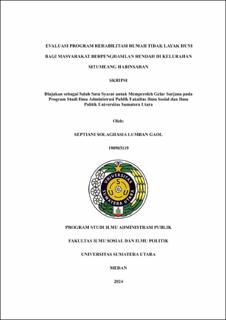| dc.description.abstract | The government, through the Ministry of Public Works and Public Housing, launched the Uninhabitable House Rehabilitation Program as an answer to the problem of rampant uninhabitable houses in Indonesia. Tapanuli Regency has been running the Uninhabitable House Rehabilitation Program since 2015, and in 2019, Situmeang Habinsaran Village received assistance for the uninhabitable house rehabilitation program. However, in its implementation, the rehabilitation program for uninhabitable houses that has been running for 8 years has not been able to answer the problem of uninhabitable houses in Situmeang Habinsaran Village because the houses repaired by the rehabilitation program for uninhabitable houses are still uninhabitable; therefore, an evaluation needs to be carried out to improve the program so that it can achieve the stated objectives.
This research uses descriptive research methods with a qualitative approach. Data collection techniques were carried out by means of interviews, observation, and documentation carried out at the Office of the Housing and Settlement Area Agency of North Tapanuli Regency. The data obtained was then analyzed qualitatively by reviewing all the data collected, which was supported by the results of interviews with the theoretical approach put forward by William N. Dunn (2003), namely: effectiveness, efficiency, adequacy, equity, accuracy, and responsiveness.
The results of this study indicate that the implementation of the rehabilitation program for uninhabitable houses in Situmeang Habinsaran Subdistrict from the aspect of effectiveness is not good enough, marked by the repair of houses that are carried out only focused on repairing roofs, floors, and walls while other components of house repairs are not repaired. The efficiency and adequacy aspects are not good enough with insufficient human resources and waste of aid funds. Aspects of equity that are not good enough due to the uneven socialization provided. The responsiveness aspect is not responsive to the recipient community, and the accuracy aspect of the rehabilitation program for uninhabitable houses is not right on target. The implementation of the Rehabilitation Program for Uninhabitable Houses in Situmeang Habinsaran Village has not gone well and has not achieved its goals. | en_US |


